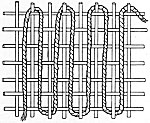|
|||||||||||||||||||||||||||||||||||||||||||||||||||||||||||||
|
|
|
||||||||||||||||||||||||||||||||||||||||||||||||||||||||||||
Dark
Mantas | Zuni Mantas | White
Mantas |
|||||||||||||||||||||||||||||||||||||||||||||||||||||||||||||
Blue Zuni Mantas
The blue embroidered mantas came from Zuni Pueblo. Their makers used plain weave for the top and bottom borders of these mantas and diagonal twill centers. A weaver wove first one border and then inverted the loom to weave the other, finishing the garment by weaving the central portion in twill. The twill weave constricted the warps more than the plain weave, so the top and bottom of the manta were wider than the middle. Finally, an embroiderer would decorate the plain weave borders.
Pueblo Stitch
Types of Garments
Mantas
Breechcloths
Kilts
Dance Sashes
Yarns & Fabrics
Persistence
Spotlight: Evelyn Bird Quintana
A Zuni black wool twill-weave manta with borders embroidered in indigo blue (c. 1870).
(IAF.T38)
The lack of contrast between the dark indigo blue embroidery yarn and the brown-black wool background produces a subtle and sophisticated garment. Apparently, Pueblos particularly prized this subtlety. Some mantas of this type were dyed after being embroidered with a native black dye, further reducing the contrast.
EnlargeThree common negative-line designs from the borders of Zuni black wool mantas: swallowtail butterfly, and hourglass figure, and diamond figures.
Zuni design conventions
The composition of design on the blue-embroidered mantas is distinct from the that of the red-embroidered mantas. The makers of the blue Zuni mantas followed strict conventions. The top and bottom selvages were closely whip stitched, followed by two rows of herringbone (or chevron) stitch. Above this small border was the main design area, a geometric pattern worked in the Pueblo stitch. Geometric representations of butterflies often appeared here. The artist worked these areas in negative patterning, using a variation of the Pueblo stitch that did not twist the strands of the doubled sewing thread. Two rows of outline stitch create a border around the main design area. This border of outline stitch also proceeds up both side selvages of the manta. The embroiderer then executed a scalloped overcast stitch across the top of the outline stitch where it flanked the main design on the top and bottom borders. Lastly, the artist worked floral motifs, placed so that they appear to be growing out of the scalloped overcast row, in satin stitch. Attributable to Spanish influence, the floral motifs stand in contrast to the overall geometric design.
Learn more about stitches used for Pueblo Embroidery.
Stitches on Zuni Mantas:
Herringbone
Outline
Overcast

SatinSchool for Advanced Research